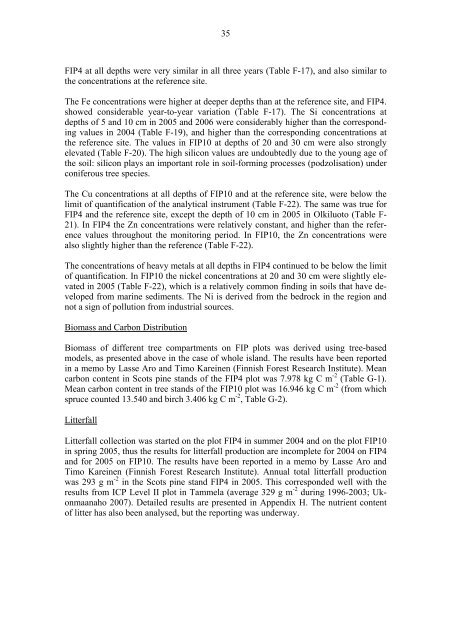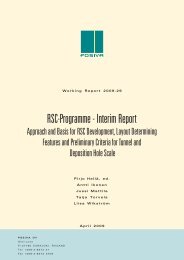34Total nitrogen (Tables F-5 and F-6), which, <strong>in</strong> addition to ammonium and nitr<strong>at</strong>e, also<strong>in</strong>cludes organic dissolved nitrogen, obviously closely followed the p<strong>at</strong>tern for the DOCconcentr<strong>at</strong>ions on both plots. In FIP4, the NH 4 -N, and especially the NO 3 -N concentr<strong>at</strong>ions,were extremely low <strong>at</strong> all depths <strong>in</strong> the m<strong>in</strong>eral soil throughout the three yearperiod (Tables F-5 and F-7). The low concentr<strong>at</strong>ions are primarily due to the fact th<strong>at</strong>nitrogen is the ma<strong>in</strong> factor limit<strong>in</strong>g tree growth <strong>in</strong> coniferous stands <strong>in</strong> F<strong>in</strong>land; theavailable nitrogen (NH 4 and NO 3 ) m<strong>in</strong>eralized from the organic layer is rapidly takenup by the roots <strong>of</strong> the trees and ground veget<strong>at</strong>ion. In FIP10 the NH 4 -N and NO 3 -Nconcentr<strong>at</strong>ions were somewh<strong>at</strong> elev<strong>at</strong>ed <strong>at</strong> a depth <strong>of</strong> 5 cm compared to the referencesite (Tables F-6 and F-8).In FIP4, sulph<strong>at</strong>e concentr<strong>at</strong>ions <strong>at</strong> a depth <strong>of</strong> 5 cm (Table F-7) were considerablylower <strong>in</strong> all three years than those <strong>at</strong> the reference site but, but <strong>at</strong> other depths wererel<strong>at</strong>ively similar. There was a clear overall <strong>in</strong>crease <strong>in</strong> sulph<strong>at</strong>e concentr<strong>at</strong>ions with<strong>in</strong>creas<strong>in</strong>g depth, apart from <strong>at</strong> 20 and 30 cm <strong>in</strong> <strong>2006</strong>. Similar trends <strong>in</strong> the sulph<strong>at</strong>econcentr<strong>at</strong>ion have been reported <strong>at</strong> all the ICP Forests Level II plots <strong>in</strong> F<strong>in</strong>land(Derome et al. 2007). In FIP10, sulph<strong>at</strong>e concentr<strong>at</strong>ions were approxim<strong>at</strong>ely the sameas the reference site <strong>at</strong> a depth <strong>of</strong> 5 cm (Table F-8), but strongly elev<strong>at</strong>ed <strong>at</strong> 20 and 30cm. Chloride concentr<strong>at</strong>ions were extremely high <strong>at</strong> all depths throughout the monitor<strong>in</strong>gperiod <strong>in</strong> both plots (Tables F-9 and F-10); it is clear th<strong>at</strong> there is a considerable<strong>in</strong>put <strong>of</strong> NaCl <strong>in</strong> deposition derived from the sea. In FIP4, chloride concentr<strong>at</strong>ions <strong>at</strong> adepth <strong>of</strong> 5 cm showed a considerably <strong>in</strong>crease over the three-year period. Phosph<strong>at</strong>econcentr<strong>at</strong>ions were <strong>at</strong> approxim<strong>at</strong>ely normal levels on both plots (Tables F-9 and F-10). Phosph<strong>at</strong>e concentr<strong>at</strong>ions are very low <strong>in</strong> soil solution <strong>at</strong> most forested sites <strong>in</strong>F<strong>in</strong>land (Derome et al. 2007).In FIP4, the concentr<strong>at</strong>ions <strong>of</strong> the three important plant nutrients (Ca, Mg, K) were rel<strong>at</strong>ivelyelev<strong>at</strong>ed, especially <strong>in</strong> the m<strong>in</strong>eral soil (10, 20 and 30 cm) <strong>at</strong> the start <strong>of</strong> themonitor<strong>in</strong>g period <strong>in</strong> 2004 (Tables F-11 to F-14). S<strong>in</strong>ce then the concentr<strong>at</strong>ions <strong>in</strong> them<strong>in</strong>eral soil have fallen and are now approach<strong>in</strong>g the levels for the reference site. Thissuggests th<strong>at</strong> there has been a short-term flush <strong>of</strong> these nutrients follow<strong>in</strong>g <strong>in</strong>stall<strong>at</strong>ion<strong>of</strong> the lysimeters (as for DOC). The K concentr<strong>at</strong>ion below the organic layer <strong>in</strong> <strong>2006</strong><strong>in</strong>creased considerably. In FIP10 the concentr<strong>at</strong>ions <strong>of</strong> all three nutrients were stronglyelev<strong>at</strong>ed <strong>at</strong> all depths <strong>in</strong> the soil (Tables F-12 and F-14). The soil <strong>at</strong> the spruce plot <strong>at</strong><strong>Olkiluoto</strong> is very young, and we<strong>at</strong>her<strong>in</strong>g processes <strong>in</strong> the m<strong>in</strong>eral soil will be rel<strong>at</strong>ivelystrong and release abundant amounts <strong>of</strong> these three nutrients.The concentr<strong>at</strong>ions <strong>of</strong> Na <strong>at</strong> all depths cont<strong>in</strong>ued to be elev<strong>at</strong>ed on both plots, due to theproximity <strong>of</strong> the sea, we<strong>at</strong>her<strong>in</strong>g <strong>of</strong> m<strong>in</strong>erals (FIP10) and there was a rel<strong>at</strong>ively strong<strong>in</strong>crease (as for K) below the organic layer <strong>in</strong> FIP4 <strong>in</strong> <strong>2006</strong>.In FIP4 the concentr<strong>at</strong>ions <strong>of</strong> total Al <strong>at</strong> all depths were similar <strong>in</strong> all three years (TableF-15), and higher than the values for the reference site <strong>at</strong> deeper (10 – 30 cm) depths.The concentr<strong>at</strong>ion <strong>of</strong> Al 3+ , which is a form <strong>of</strong> Al th<strong>at</strong> is toxic to plant roots and mycorrhizas,was still extremely low <strong>at</strong> a depth <strong>of</strong> 5 cm, but considerably higher <strong>at</strong> theother depths compared with the reference site. However, they are still much lower thanthe widely accepted toxicity level <strong>of</strong> 2 mg/l. In FIP10 the total Al concentr<strong>at</strong>ions werelower <strong>at</strong> a depth <strong>of</strong> 5 cm, but the Al 3+ (Table F-16) and Mn concentr<strong>at</strong>ions (Table F-18)were rel<strong>at</strong>ively similar to the reference values <strong>at</strong> all depths. The Mn concentr<strong>at</strong>ions <strong>of</strong>
35FIP4 <strong>at</strong> all depths were very similar <strong>in</strong> all three years (Table F-17), and also similar tothe concentr<strong>at</strong>ions <strong>at</strong> the reference site.The Fe concentr<strong>at</strong>ions were higher <strong>at</strong> deeper depths than <strong>at</strong> the reference site, and FIP4.showed considerable year-to-year vari<strong>at</strong>ion (Table F-17). The Si concentr<strong>at</strong>ions <strong>at</strong>depths <strong>of</strong> 5 and 10 cm <strong>in</strong> 2005 and <strong>2006</strong> were considerably higher than the correspond<strong>in</strong>gvalues <strong>in</strong> 2004 (Table F-19), and higher than the correspond<strong>in</strong>g concentr<strong>at</strong>ions <strong>at</strong>the reference site. The values <strong>in</strong> FIP10 <strong>at</strong> depths <strong>of</strong> 20 and 30 cm were also stronglyelev<strong>at</strong>ed (Table F-20). The high silicon values are undoubtedly due to the young age <strong>of</strong>the soil: silicon plays an important role <strong>in</strong> soil-form<strong>in</strong>g processes (podzolis<strong>at</strong>ion) underconiferous tree species.The Cu concentr<strong>at</strong>ions <strong>at</strong> all depths <strong>of</strong> FIP10 and <strong>at</strong> the reference site, were below thelimit <strong>of</strong> quantific<strong>at</strong>ion <strong>of</strong> the analytical <strong>in</strong>strument (Table F-22). The same was true forFIP4 and the reference site, except the depth <strong>of</strong> 10 cm <strong>in</strong> 2005 <strong>in</strong> <strong>Olkiluoto</strong> (Table F-21). In FIP4 the Zn concentr<strong>at</strong>ions were rel<strong>at</strong>ively constant, and higher than the referencevalues throughout the monitor<strong>in</strong>g period. In FIP10, the Zn concentr<strong>at</strong>ions werealso slightly higher than the reference (Table F-22).The concentr<strong>at</strong>ions <strong>of</strong> heavy metals <strong>at</strong> all depths <strong>in</strong> FIP4 cont<strong>in</strong>ued to be below the limit<strong>of</strong> quantific<strong>at</strong>ion. In FIP10 the nickel concentr<strong>at</strong>ions <strong>at</strong> 20 and 30 cm were slightly elev<strong>at</strong>ed<strong>in</strong> 2005 (Table F-22), which is a rel<strong>at</strong>ively common f<strong>in</strong>d<strong>in</strong>g <strong>in</strong> soils th<strong>at</strong> have developedfrom mar<strong>in</strong>e sediments. The Ni is derived from the bedrock <strong>in</strong> the region andnot a sign <strong>of</strong> pollution from <strong>in</strong>dustrial sources.Biomass and Carbon DistributionBiomass <strong>of</strong> different tree compartments on FIP plots was derived us<strong>in</strong>g tree-basedmodels, as presented above <strong>in</strong> the case <strong>of</strong> whole island. The results have been reported<strong>in</strong> a memo by Lasse Aro and Timo Kare<strong>in</strong>en (F<strong>in</strong>nish Forest Research Institute). Meancarbon content <strong>in</strong> Scots p<strong>in</strong>e stands <strong>of</strong> the FIP4 plot was 7.978 kg C m -2 (Table G-1).Mean carbon content <strong>in</strong> tree stands <strong>of</strong> the FIP10 plot was 16.946 kg C m -2 (from whichspruce counted 13.540 and birch 3.406 kg C m -2 , Table G-2).LitterfallLitterfall collection was started on the plot FIP4 <strong>in</strong> summer 2004 and on the plot FIP10<strong>in</strong> spr<strong>in</strong>g 2005, thus the results for litterfall production are <strong>in</strong>complete for 2004 on FIP4and for 2005 on FIP10. The results have been reported <strong>in</strong> a memo by Lasse Aro andTimo Kare<strong>in</strong>en (F<strong>in</strong>nish Forest Research Institute). Annual total litterfall productionwas 293 g m -2 <strong>in</strong> the Scots p<strong>in</strong>e stand FIP4 <strong>in</strong> 2005. This corresponded well with theresults from ICP Level II plot <strong>in</strong> Tammela (average 329 g m -2 dur<strong>in</strong>g 1996-2003; Ukonmaanaho2007). Detailed results are presented <strong>in</strong> Appendix H. The nutrient content<strong>of</strong> litter has also been analysed, but the report<strong>in</strong>g was underway.
- Page 1 and 2: Working Report 2007-52Results of Mo
- Page 3 and 4: ABSTRACTThis Working Report present
- Page 5: 1TABLE OF CONTENTSABSTRACTTIIVISTEL
- Page 9 and 10: 52 MONITORING SYSTEM AND SCHEDULETh
- Page 11 and 12: 73 RESULTS AND DISCUSSION3.1 Landsc
- Page 13 and 14: 9Table 4. Distribution of Olkiluoto
- Page 15 and 16: 113.2 Input to Biosphere Modelling3
- Page 17 and 18: 13The soils were acid. The organic
- Page 19: 15Table 8. Total concentrations (%)
- Page 22 and 23: 18Soil MicrobesCarbon (C) and nitro
- Page 24 and 25: 201.2Norway spruceScots pine10.8mg/
- Page 26 and 27: 22Figure 13. The biomass distributi
- Page 28 and 29: 24Table 13. Mean carbon content (g/
- Page 30 and 31: 26700600500400300200Open areaForest
- Page 32 and 33: 28fall (Table E-4) was lower than t
- Page 34 and 35: 30160140120Percolation waterStand t
- Page 36 and 37: 3265pH432200420052006Ref. 1998-2000
- Page 40 and 41: 36DefoliationThe degree of defoliat
- Page 42 and 43: 38302520Temperature at 9 mPAR at 24
- Page 44 and 45: 40Exceptionally, only two raccoon d
- Page 46 and 47: 42The discharge and the nutrients o
- Page 48 and 49: 44In general, the open water season
- Page 50 and 51: 4665Substance matter, mg/l432SEA03S
- Page 52 and 53: 48Biomass, mg/m32000180016001400120
- Page 54 and 55: 50450040003500Individuals/m23000250
- Page 56 and 57: 5212000kg100008000600040002000Balti
- Page 58 and 59: 54Figure 41. Noise levels (L AT , d
- Page 60 and 61: 56phenomenon, especially in dry sum
- Page 62 and 63: 58On the southern part of the islan
- Page 64 and 65: 60The water quality of the monitore
- Page 66 and 67: 62Kaunisto, S. & Moilanen, M. 1998.
- Page 68 and 69: 64Starr, M. 1991. Soil formation an
- Page 70 and 71: 66Table A-1 cont'd. Monitoring site
- Page 72 and 73: 68Table A-1 cont'd. Monitoring site
- Page 75 and 76: 71APPENDIX B: FOREST AND MIRE MONIT
- Page 77 and 78: 73comprehensive measurement of fore
- Page 79 and 80: 75Figure B-4. Top: FIP10, middle: F
- Page 81 and 82: 77Table B-3. Coverage (%) and numbe
- Page 83: 79Figure B-5. Litterfall samplers (
- Page 86 and 87: Table C-2. Radionuclides in air in
- Page 88 and 89:
84Table C-3. Radionuclides in milk
- Page 90 and 91:
86Table C-7. Radionuclides in fish
- Page 93:
APPENDIX D. RESULTS FROM SOIL MICRO
- Page 96 and 97:
Table E-3. Annual amount of precipi
- Page 98 and 99:
94Table E-5. Annual bulk deposition
- Page 100 and 101:
96Table F-3. Mean pH and dissolved
- Page 102 and 103:
98Table F-11. Mean calcium (Ca, mg/
- Page 104 and 105:
100Table F-19. Mean silicon (Si, mg
- Page 106 and 107:
102
- Page 108 and 109:
104
- Page 110 and 111:
106
- Page 112 and 113:
108Table J-3. The concentrations of
- Page 114 and 115:
110Table J-9. Primary production (m
- Page 116:
112Table K-2. Chemical analyses of
















